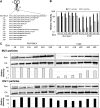Sequence Determinants in Gammaretroviral Env Cytoplasmic Tails Dictate Virus-Specific Pseudotyping Compatibility
- PMID: 30894464
- PMCID: PMC6532079
- DOI: 10.1128/JVI.02172-18
Sequence Determinants in Gammaretroviral Env Cytoplasmic Tails Dictate Virus-Specific Pseudotyping Compatibility
Abstract
Viruses can incorporate foreign glycoproteins to form infectious particles through a process known as pseudotyping. However, not all glycoproteins are compatible with all viruses. Despite the fact that viral pseudotyping is widely used, what makes a virus/glycoprotein pair compatible is poorly understood. To study this, we chose to analyze a gammaretroviral glycoprotein (Env) whose compatibility with different viruses could be modulated through small changes in its cytoplasmic tail (CT). One form of this glycoprotein is compatible with murine leukemia virus (MLV) particles but incompatible with human immunodeficiency virus type 1 (HIV-1) particles, while the second is compatible with HIV-1 particles but not with MLV particles. To decipher the factors affecting virus-specific Env incompatibility, we characterized Env incorporation, maturation, cell-to-cell fusogenicity, and virus-to-cell fusogenicity of each Env. The HIV-1 particle incompatibility correlated with less efficient cleavage of the R peptide by HIV-1 protease. However, the MLV particle incompatibility was more nuanced. MLV incompatibility appeared to be caused by lack of incorporation into particles, yet incorporation could be restored by further truncating the CT or by using a chimeric MLV Gag protein containing the HIV-1 MA without fully restoring infectivity. The MLV particle incompatibility appeared to be caused in part by fusogenic repression in MLV particles through an unknown mechanism. This study demonstrates that the Env CT can dictate functionality of Env within particles in a virus-specific manner.IMPORTANCE Viruses utilize viral glycoproteins to efficiently enter target cells during infection. How viruses acquire viral glycoproteins has been studied to understand the pathogenesis of viruses and develop safer and more efficient viral vectors for gene therapies. The CTs of viral glycoproteins have been shown to regulate various stages of glycoprotein biogenesis, but a gap still remains in understanding the molecular mechanism of glycoprotein acquisition and functionality regarding the CT. Here, we studied the mechanism of how specific mutations in the CT of a gammaretroviral envelope glycoprotein distinctly affect infectivity of two different viruses. Different mutations caused failure of glycoproteins to function in a virus-specific manner due to distinct fusion defects, suggesting that there are virus-specific characteristics affecting glycoprotein functionality.
Keywords: Env incorporation; HIV-1; MLV; R peptide; assembly; cytoplasmic tail; fusogenicity; glycoprotein; retrovirus.
Copyright © 2019 American Society for Microbiology.
Figures









Similar articles
-
The Interplay between HIV-1 Gag Binding to the Plasma Membrane and Env Incorporation.Viruses. 2020 May 16;12(5):548. doi: 10.3390/v12050548. Viruses. 2020. PMID: 32429351 Free PMC article. Review.
-
Intracellular trafficking of Gag and Env proteins and their interactions modulate pseudotyping of retroviruses.J Virol. 2004 Jul;78(13):7153-64. doi: 10.1128/JVI.78.13.7153-7164.2004. J Virol. 2004. PMID: 15194792 Free PMC article.
-
In Vivo Analysis of Infectivity, Fusogenicity, and Incorporation of a Mutagenic Viral Glycoprotein Library Reveals Determinants for Virus Incorporation.J Virol. 2016 Jun 24;90(14):6502-14. doi: 10.1128/JVI.00804-16. Print 2016 Jul 15. J Virol. 2016. PMID: 27147747 Free PMC article.
-
Pseudotyping incompatibility between HIV-1 and gibbon ape leukemia virus Env is modulated by Vpu.J Virol. 2010 Mar;84(6):2666-74. doi: 10.1128/JVI.01562-09. Epub 2009 Dec 30. J Virol. 2010. PMID: 20042505 Free PMC article.
-
Mechanisms for Env glycoprotein acquisition by retroviruses.AIDS Res Hum Retroviruses. 2011 Mar;27(3):239-47. doi: 10.1089/AID.2010.0350. Epub 2011 Feb 22. AIDS Res Hum Retroviruses. 2011. PMID: 21247353 Free PMC article. Review.
Cited by
-
Analysis of HIV-1 Matrix-Envelope Cytoplasmic Tail Interactions.J Virol. 2019 Oct 15;93(21):e01079-19. doi: 10.1128/JVI.01079-19. Print 2019 Nov 1. J Virol. 2019. PMID: 31375589 Free PMC article.
-
Structures of immature EIAV Gag lattices reveal a conserved role for IP6 in lentivirus assembly.PLoS Pathog. 2020 Jan 27;16(1):e1008277. doi: 10.1371/journal.ppat.1008277. eCollection 2020 Jan. PLoS Pathog. 2020. PMID: 31986188 Free PMC article.
-
The Interplay between HIV-1 Gag Binding to the Plasma Membrane and Env Incorporation.Viruses. 2020 May 16;12(5):548. doi: 10.3390/v12050548. Viruses. 2020. PMID: 32429351 Free PMC article. Review.
-
Interaction Interface of Mason-Pfizer Monkey Virus Matrix and Envelope Proteins.J Virol. 2020 Sep 29;94(20):e01146-20. doi: 10.1128/JVI.01146-20. Print 2020 Sep 29. J Virol. 2020. PMID: 32796061 Free PMC article.
References
Publication types
MeSH terms
Substances
Grants and funding
LinkOut - more resources
Full Text Sources
Research Materials
Miscellaneous

